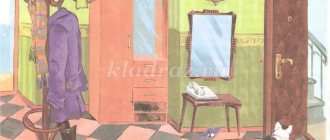“Zoo” – entertainment summary
Gashchenko Zoya Vitalievna teacher-speech therapistMADOU “Child Development Center - kindergarten No. 2g. Shebekino, Belgorod region
The material was sent for publication in the All-Russian printed collection of practice-oriented materials “Preschool and primary education - modern methods and technologies of teaching and upbringing” - SEPTEMBER 2022.
ZOO summary of entertainment for older children with special needs
Program content:
- develop proper breathing (according to A. Strelnikova’s method);
- teach basic self-massage techniques;
- develop children’s visual and auditory perception, sense of tempo and rhythm;
- develop prolonged speech exhalation using onomatopoeia material;
- expand articulatory capabilities;
- develop children’s motor memory, coordinated relationship between speech and movement;
- improve gross and fine motor skills;
- optimize overall body tone;
- develop stability and switchability of attention, imagination;
- develop a positive emotional background.
Advertising message
Methodical techniques: story about a game situation; display of movements, facial expressions and gestures; explanation of the rules of the game and exercises; help, encouragement.
Progress:
(The speech therapist attaches drawings to the exhibition) - Here is the last drawing of our exhibition, let’s look at it now.
-What happened to the rhinoceros? The rhinoceros has lost its horn! The hippopotamus is angry for a reason, because it is drawn without a tail. And with the giraffe there’s a real incident: There’s a neck, but below that there’s an ostrich! The poor crocodile is crying: He wants to go from the desert to the Nile! The monkey is surprised: On the nose, where does the bump come from?
Speech therapist : - Guys, what did you draw? Have you seen any animals or been to the zoo?
Guys: - We’ve never been and we want to go there quickly!
Speech therapist: - Grab the rope and stand in a circle, so that no one gets lost or ends up in the zoo!
Massage of fingers with a rope in knots: (Actions are carried out according to the text)
Hand to hand, knot in fist, shake the knot, rub it with your fingers. We twist on our palms, skip in our fists, 1,2,3. 1,2,3 – we are walking, look!
They sing: “It’s fun to walk together...” (walking in a circle with knees raised high).
Hippopotamuses - In this cage by the gate lives a fat hippopotamus, He is waiting for someone to scratch his back, He lies covered in dirt, like a pig.
Back massage “Hippopotamus”. Children stand one after another
Like on a typewriter - they tap with their fingers. The hippopotamus is like a pig. Everything taps, - they tap with their palms. Everything grunts: Knock-knock-knock-knock! – tapping their fistsGrunts-grunts-grunts-grunts! - stroke with palms. Children turn 180* and repeat the massage again.
Teasers: – Why doesn’t the hippopotamus come out of the water? Let's get him out of there somehow.
Right there, there lies a fat hippopotamus. Ota-ota-ota - be afraid of the mouth of a hippopotamus. It doesn’t work, let’s try with stones. Your pebbles will fall into the water like this: Glug-glug-glug, glug, glug. And yours is like this: glug, glug, glug - glug, glug, glug. They throw stones in pairs.
- Guys, what does it say there? “You can’t tease animals!” (read).
-Poor, poor hippopotamus, Sleeps in the lake all year round, Does not come out of the water, As if there were no trouble! Otherwise it may happen that he turns into a fish. - Guys, let's catch some fish for the hippopotamus.
Outdoor game “Catch, fish!” Children attach a ribbon with a ring to the back of their belt. The participants are faced with the task of catching as many fish as possible, tearing off the ribbon from their opponents, while trying to keep theirs. A player who loses his fish is eliminated from the game.
- Guys, I also caught some difficult fish. Every fish has its own smile!
Lip exercise “Fish – smile”.
If it's a fish, it has a smile. If it's a fish, it has a smile. If it is a fish, it has a smile. If it is a fish, it has a smile. If it's a fish, it has a smile. - Eat the fish, hippopotamus, open your huge mouth! - Guys, where did the sparrow have lunch? At the zoo with the animals, he first dined on a crust of bread from the lion.
LIONS.
Facial massage “Sparrow”:
| A sparrow sat on a cage and swayed on it | Both palms are drawn from the eyebrows to the chin and back up. |
| 1,2,3,4,5 - you need to peck some bread. 1,2,3,4,5 – reluctance to fly away | Massage the temporal cavities with the thumbs of both hands, making rotational movements. |
Phonopedic exercise “Leo”:
A lion saw the sparrow: r-rr-r - in the middle register His mouth grinned, going wild: r-rr-r - in the high register He jumped up to his full height: r-rr-r - in the low register And the tail remained in his teeth: r-rr-r - long exhalation.
Psychomuscular training “Shaking” to stimulate the body’s metabolic processes (according to M. Lazarev):
I.P. – main stand. Completely relax the body and shake all parts, trying to vibrate even the internal organs.
– We are afraid, we are trembling! We'll run away from here!
- Guys, can you hear, it’s raining! “Drip-drip-drip - raindrops are knocking” (oilcloth with pimples). Fine motor skills, relaxation.
-Drip-drip-drip - raindrops are knocking. Paws get wet, backs get wet - Life in an enclosure is not easy. There is no sun, only clouds.
Dynamic pause “Clouds and puddles will become friends with rain”:
How quickly the clouds float across the sky! - they swing their raised arms, one looks like a hunchbacked horse, - they “jump” in a circle, the other is open, like a coat, - arms to the sides, a turn of the body, and the third, it looks like I don’t know what! - they shrug their shoulders. We’ll wait a little, - we sat down. The cloud will become rain. - they get up, spin around with their hands raised, and now with his water - they “scoop up” water with their palms. The animals will all be able to drink! - bend forward, hands behind your back. - Children, collect some rainwater, give it to all the animals to drink! (Children lay out “puddles” - silhouettes of animals, respectively.)
ELEPHANTS : - Oh, guys, look! There’s a baby elephant in a cage, he’s still so small, he climbed onto the bed, probably tired!
Gymnastics for legs “Elephant” (N. Pikuleva): Oh-oh-oh! They rise up on their toes, then on their heels. The elephant fell asleep on the bed. Two bare heels dangled from the crib. (Rise on your toes and heels, placing your feet on the same line with your toes inward). Two barefoot, two funny, oh, funny heels! (They rise on their toes and on their heels, placing their feet with their toes outward). A mouse saw it, a naughty mouse, (They shift from foot to foot). She climbed onto the crib, grabbed his heel, (they lunge with their foot forward. Then they turn 180*, changing the supporting leg) - Look, guys, the elephant woke up.
Exercise for neck muscles “Elephant”
Elephant-elephant, a real living elephant, (They tilt their head back and forth) Why do you keep shaking your head? - Because, because, because, - (Tilt their head to the right and left) I keep thinking, my friend, and I don’t understand, Why an evil fly stuck to me, It will sit on my trunk, or on my ear (Stroke my neck with my palm from top to bottom ).
Gymnastics for the eyes “Fly” (M.Yu. Kartushina “We want to be healthy”, M., -2004). The fly buzzed loudly, began to hover over the baby elephant (Stretch out your hand forward and describe a circle in the air with your index finger, tracing the movement with your eyes.) The fly, the fly flew (Touch the tip of the nose with your finger) And sat on the elephant’s trunk. (focus on the fingertip). The fly flew again, and landed on the ear (They touch the ear, tracing the movement of the finger within sight, without turning the head). It flew, flew, and landed on the second ear, (They also slowly touch the second ear, tracing the movements with their eyes). The fly up , and fly down. Well, baby elephant, watch out! (They move their gaze sharply up, down, right, left, fixing it on the tip of the finger). Our elephant closed his eyes - the fidget flew away! – (Press your palms tightly against your open eyes so that light does not penetrate through them.)
GIRAFFE
-Whose ear can’t a fly reach? (before giraffe)
A giraffe walks around the zoo, He reminds us of a horse, He runs quickly and sleeps standing, When he runs, we hear the sound of hooves.
Attention game "Giraffe"
Children run in circles to the music. For one beat of the tambourine they turn 180*, for 2 they freeze and listen, and for 3 they bend over (“a giraffe is nibbling the grass”).
-Guys, look at the giraffe. He senses danger, he listens and sniffs!
Breathing exercises (according to A. Strelnikova):
- Turn your head left and right, taking a noisy short breath through your nose at each turn.
- Tilt your head to the sides, forward and back with similar breaths.
“I see who’s sneaking here!” He doesn't like noisy games - he's a scary, angry tiger!
TIGERS General developmental exercises “Tiger”:
- “The tiger is out hunting, he is sneaking” - the children walk in a circle, “sneaking.”
- “The tiger is looking for prey” - I.p. - sit down, hands rest freely on your knees.
Turn your torso to the right, without removing your hands from your knees, while simultaneously moving your tongue along the upper teeth from the front to the molars in the direction of rotation. Repeat the same on the left side.
- “The tiger has found prey” - Get on your knees, spreading your tense fingers, sticking out your tongue to the limit, look up and growl: “Rrrr”, changing the strength of the sound at the command of the speech therapist.
- How he scared us! It's good that he ran away!
Guys, look at someone's nest, how nice the eggs are.
CROCODILE. Finger game “Crocodile masonry” (massage balls “Su-Jok”)
Whose masonry is this? The ball is rolled horizontally between the palms, like a white egg, smooth! Rotate the ball with the fingers of both hands. Maybe any birds? Roll on the back of the left hand. Maybe the chicken is pockmarked? Roll on the back of the right hand Or did the lizard put it aside? Are they rotated on the left palm, or has the turtle forgotten them? Rotate on the right palm - I laid an egg! They put the ball down and take the spring. This is crocodile laying! They massage each finger with a spring. If he grabs someone, the crocodile won’t let go! The animals by the river remember His sharp fangs!
Phonopedic exercise “Exotic animals” (according to V. Emelyanov, I. Trifonova)
We hear, we hear a crocodile voice - xxx, It is not low, not high - xxx, Rumbling, rustling, creaking and grinding - xxx, Its mouth opens - it hurts our ears - xxx. -The crocodile was not expecting guests, and especially not children. We'd better get out of here, no more animals here! Here, for example, are monkeys. Let's give them bananas now!
- Guys, what does it say here? They read: “Don’t feed the animals! Don’t litter at the zoo!” Well, you can play with them!
MONKEY
Ri
- Monkeys love to repeat movements, "Lanterns" left and right. They love to jump, run, and also play! Jumping in a circleEx. Tra-ta-ta, tra-ta-ta - They clap their hands to the beat. Here's an exercise for the tail! Hands on the belt, “tails wagging.
- Monkeys love to climb high and show jumping on the spot. After all, getting bananas from a palm tree is not easy. Jump in a circle. – You guys are great! Get the lollipops!
Finger game “Lollipops” (with a ribbed stick):
Tsyntsy, bryntsy, bryntsy-tsy! Roll vertically between palms. Children love lollipops. Lollipops, crackers, Chupa-chups-balls! Roll Kinders, nuts, Flakes, Kirieshki on the fingertips in turn with each hand! The fingers of one hand are held vertically, the fingers of the other hand slide up and down on the stick, change hands Eat delicious chocolate (Roll horizontally between the deer) Everyone will be happy! (Switch hands). -Here are your lollipops! (Lollipop) Hurry up to kindergarten, grab the rope! So that no one gets lost, No one stays in the zoo! Together, walk merrily, don’t lag behind me! (They take hold of the “snake” rope) They leave. The fun is over.
You can see the table of authors and learn more about the collections HERE





